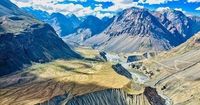On the windswept plateaus and rugged valleys of Himachal Pradesh’s Lahaul-Spiti district, a remarkable milestone in conservation has just been achieved. UNESCO has added the Cold Desert Biosphere Reserve to its World Network of Biosphere Reserves (WNBR), making it India’s 13th entry on this prestigious global list. The announcement, made during the 37th session of UNESCO’s International Coordinating Council of the Man and the Biosphere (MAB) in Paris and echoed at the fifth World Congress of Biosphere Reserves in Hangzhou, China, signals not only international recognition but also a new chapter for India’s efforts to balance ecological protection with sustainable livelihoods.
Spanning approximately 7,770 square kilometers at altitudes ranging from 3,300 to 6,600 meters, the Cold Desert Biosphere Reserve encompasses a dramatic sweep of the trans-Himalayan landscape. According to UNESCO, this region is one of the coldest and driest ecosystems in the world, featuring windswept plateaus, glacial valleys, alpine lakes, and high-altitude deserts. The reserve brings together several iconic protected areas, including Pin Valley National Park, Kibber Wildlife Sanctuary, Chandratal Wetland, and the Sarchu plains—each a hub of biodiversity and cultural heritage.
But what exactly makes this cold desert so special? For starters, its biodiversity is both rich and fragile. The reserve harbors 732 species of vascular plants, including 30 endemics and 157 near-endemics of the Indian Himalayas, as noted by UNESCO. Among these, 47 are medicinal herbs crucial to the traditional Sowa Rigpa (Amchi) healing system, a centuries-old practice rooted in Tibetan culture. The region’s fauna is no less impressive: the elusive snow leopard, Himalayan ibex, blue sheep, Himalayan wolf, golden eagle, and Himalayan snowcock all find sanctuary here, according to reports from Down To Earth and The Hindu.
Yet, the Cold Desert is not just a haven for wildlife and rare plants. Around 12,000 residents live in scattered villages across the reserve, practicing traditional pastoralism, yak and goat herding, and small-scale farming of barley and peas. These communities, deeply influenced by Buddhist monastic traditions, also maintain ancient Tibetan herbal medicine customs. Local councils and monasteries play a crucial role in managing the use of fragile alpine resources, ensuring that conservation goes hand-in-hand with sustaining livelihoods.
The biosphere reserve is thoughtfully divided into three zones: a core area of 2,665 square kilometers dedicated to strict protection, a buffer zone of 3,977 square kilometers where limited human activity is permitted, and a transition area of 1,128 square kilometers that balances conservation with sustainable community practices. This zoning, as highlighted by the Union Environment Ministry, exemplifies India’s broader strategy to integrate ecological preservation with local development.
The timing of this recognition couldn’t be more significant. Globally, UNESCO has added 26 new biosphere reserves across 21 countries this year—the highest number in two decades—expanding the WNBR to 785 sites in 142 countries. “With nearly thirty new designations this year, our World Network of Biosphere Reserves has reached a major milestone, now protecting 5 percent of the planet,” said UNESCO Director-General Audrey Azoulay, as quoted by The Hindu. She added, “UNESCO will continue to mobilize states, scientists, civil society, and local and Indigenous communities to continue this positive momentum.”
For India, the Cold Desert Biosphere Reserve’s inclusion is more than a feather in the cap. It reflects a growing commitment to biodiversity conservation and sustainable development. Union Minister for Environment and Forests Bhupender Yadav emphasized, “With this addition, India now proudly has 13 biospheres listed in UNESCO’s World Network of Biosphere Reserves, which reflects India’s commitment towards biodiversity conservation and community-led sustainable development.” He also noted that the move comes soon after two new Ramsar sites were added, bringing India’s total wetlands of international importance to 93.
Tim Curtis, Director of UNESCO’s Regional Office for South Asia, underscored the significance of the achievement: “The Cold Desert Biosphere Reserve is a powerful example of how fragile ecosystems can be protected while supporting the communities that depend on them. This designation reflects India’s commitment to balancing conservation with sustainable development.”
The global spotlight on the Cold Desert Biosphere Reserve is expected to catalyze further research collaborations, promote responsible tourism, and enhance climate resilience strategies in high-altitude mountain ecosystems. According to Devdiscourse, the designation will also foster international cooperation for research and reinforce India’s climate resilience efforts—an urgent need as Himalayan ecosystems face mounting threats from climate change and unchecked tourism.
India’s biosphere reserves now represent a tapestry of diverse ecosystems, from the tropical forests of the Nilgiri and Sundarbans to the island wilderness of Great Nicobar and the sal forests of Pachmarhi. The addition of the Cold Desert brings a unique high-altitude, cold-arid ecosystem into this network, highlighting the country’s ecological and cultural diversity.
The recognition arrives as UNESCO’s Man and the Biosphere Programme marks its 50th anniversary, a fitting backdrop to a renewed call for every member state to establish at least one biosphere reserve by 2035. During the Congress in Hangzhou, more than 2,000 international experts, public decision-makers, civil society members, Indigenous representatives, and youth gathered to take stock of the programme’s achievements and chart its course for the coming decade.
For the residents of Lahaul-Spiti, UNESCO’s nod is both a validation and a new responsibility. Their centuries-old practices—whether tending yaks on the slopes, harvesting medicinal herbs, or preserving Buddhist rituals—are now recognized as part of a global heritage. The hope, as echoed by local leaders and conservationists, is that this designation will bring not just international attention but also tangible benefits: improved infrastructure, sustainable tourism, better research facilities, and, crucially, a stronger voice in decisions about their land.
As the world looks to innovative ways of balancing nature conservation with human needs, the story of the Cold Desert Biosphere Reserve stands out. It’s a testament to what’s possible when local wisdom, scientific research, and international cooperation come together. From the rare snow leopard to the resilient mountain communities, the Cold Desert’s inclusion in UNESCO’s global network sends a clear message: protecting our planet’s most fragile places is a shared responsibility—one that demands both reverence for tradition and readiness for change.


